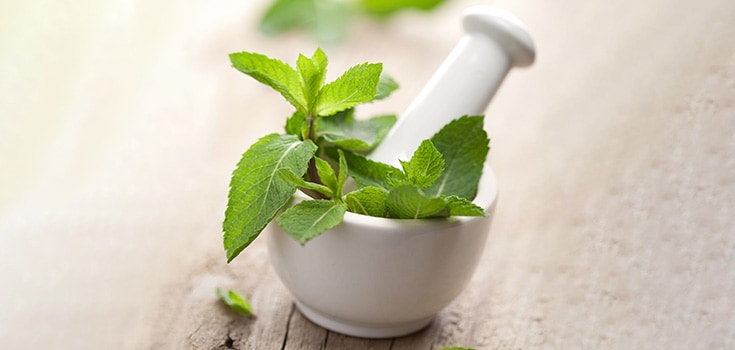Grow Your Own Medicine: Peppermint Tea Benefits

There are several species of mint and hundreds of varieties. It seems lately, the choices at local greenhouses have gotten more and more diverse, with orange mint, apple mint, and even chocolate mint. To say these plants are easy to grow would be an understatement. More accurately, they are difficult to kill. With a little background and a few tips, you can reap the many medicinal benefits of mint right at home and leave behind several different traditional over-the-counter solutions. For our purposes, we will focus on peppermint – peppermint tea benefits are some of the most established due to the popularity of the tea.
Background
While other mints are great for teas and may provide some of the same benefits, peppermint is more versatile and easiest to find.
It’s been used for millennia, reportedly put into use in prehistoric Europe and North Africa somewhere around 1,000 B.C. Mint has made the rounds. During days of plague, it was combined with rosemary to mask the smell of death. It was also used to repel mice, rats, and flies. More pleasantly, it’s been used to scent homes and the people of Athens reportedly believed it to bring clarity and insight.
Of course, around the world, mint was also used in medicinal preparations.
Health Benefits of Mint – Peppermint Tea Benefits
The calming and numbing benefits of peppermint are responsible for many of its medicinal uses. According to the University of Maryland, the mint has antibacterial, antifungal, and antiviral properties—making it a powerful plant.
Most commonly, mint is used to calm the digestive system. It is effective in relaxing the muscles of the stomach and intestines, and has therefore been used to treat:
- Gas and bloating
- Indigestion
- Irritable bowel syndrome (IBS)
- Nausea
- Diarrhea
- And even hiccups
It’s also said to be effective at treating tension headaches when applied to the forehead and temples.
Finally, the active component within, called menthol, can actually thin mucous. This makes it a good treatment for a stuffy nose, chest congestion, and the soothing of coughs related to colds or the flu.
In aromatherapy, mint is said to increase alertness and focus. It reportedly calms the muscles, especially those of the digestive tract. Inhaling the vapors can relieve headaches and clear sinuses.
How to Use It
Generally, in home herbal care, peppermint tea is by far the simplest way to reap its benefits. For two cups, use two teaspoons of dried peppermint leaves or two tablespoons of fresh leaves. Cover them with two cups of boiling water and allow to steep for about 10 minutes. Strain off the leaves and enjoy!
How to Grow It
Mint isn’t just simple to grow, it will literally take over a yard if you let it. Because of this, it makes a perfect container plant. Choose a large pot, so that you’ll have plenty of leaves for your medicinal tea. A 12-inch pot should be good to start with, but remember: the way mint proliferates, you will be re-potting it on a regular basis.
While you can grow mint from seeds, but you’ll likely get better flavor if you start with a young plant purchased from a local organic greenhouse or garden center.
Your mint will love the morning sun, but may want some partial afternoon shade as well, so position it accordingly. (It will also do okay indoors, as long as it gets morning sunlight and is placed away from heating elements). Water it regularly, as mint grows best in moist conditions.
Last but not least, these plants produce pretty flowers. But, if you are growing it for potent leaves, you can help keep the plant’s energy focused on these leaves by cutting back the flowers as they pop up. If, however, you want to keep the flowers around, they will attract many bees and make a great addition to a backyard ecosystem.
Additional Sources:

I drink a lot of mint tea. I use mint to make sun tea in the summer. I know of the many health benefits but didn't know it could help with hiccups! I'll have to give it a try next time I get the hiccups.
This article is absolutely informative! Peppermint is indeed so beneficial to people's health. So refreshing and healthy! Thanks for sharing!
This is such a helpful post. Indeed, Peppermint tea can be planted in anyone's backyard. And the benefits that it could give is more than what I expected. I'm very much into this post as I somehow, would like to help my hubby feel more relaxed every time he is home. And peppermint is a good option. Mary Nauman, Massage Stroudsburg PA
I all the time emailed this web site post page to all my contacts, for the reason that if
like to read it then my contacts will too.
Really got into the organic tea as a food for breakfast when I started living on my own in the city. Tea made my diet very healthy.